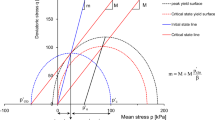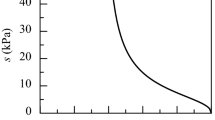Abstract
In this paper, an elastoplastic constitutive model is proposed to uniformly describe the mechanical behavior of cemented/ non-cemented soil under different loading conditions. A state variable characterizing the degree of cementation is introduced into the yield function of the cyclic mobility model, and an evolution rule is proposed to describe the degradation of cementation and structure. Since the cyclic mobility model is developed based on the concepts of subloading surface and superloading surface, the newly proposed model inherits both its advantages and can systematically describe the effects of cementation, structure, overconsolidation, and stress-induced anisotropy on the mechanical behavior of soil. Compared with cyclic mobility model, this proposed model adds only one state variable associated with cementation, which has clear physical meaning and can be determined by uniaxial compression or tension test. The capability of the proposed model has been validated carefully through a series of tests such as isotropic, uniaxial, and triaxial tests under monotonic and cyclic loading conditions.











Similar content being viewed by others
References
Asaoka A, Nakano M, Noda T (2000) Superloading yield surface concept for highly structured soil behavior. Soils Found 40(2):99–110
Asaoka A, Noda T, Yamada E, Kaneda K, Nakano M (2002) An elasto-plastic description of two distinct volume change mechanisms of soils. Soils Found 42(5):47–57
Azadi M, Ghayoomi M, Shamskia N, Kalantari H (2017) Physical and mechanical properties of reconstructed bio-cemented sand. Soils Found 57(5):698–706
Bono JD, McDowell G, Wanatowski D (2015) Investigating the micro mechanics of cemented sand using DEM. Int J Numer Anal Methods Geomech 39(6):655–675
Borja RI, Yin Q, Zhao Y (2019) Cam-clay plasticity part IX: on the anisotropy, heterogeneity, and viscoplasticity of shale. Comput Methods Appl Mech Eng 360:112695
Choobbasti AJ, Vafaei A, Soleimani KS (2018) Static and cyclic triaxial behavior of cemented sand with nanosilica. J Mater Civ Eng 30(10):04018269
Consoli NC, Morales DP, Saldanha RB (2021) A new approach for stabilization of lateritic soil with Portland cement and sand: strength and durability. Acta Geotech 16(12):1473–1486
Cui MJ, Zheng JJ, Dahal BK, Lai HJ, Wu CC (2021) Effect of waste rubber particles on the shear behaviour of bio-cemented calcareous sand. Acta Geotech 16(6):1429–1439
Cui MJ, Zheng JJ, Zhang RJ, Lai HJ, Zhang J (2017) Influence of cementation level on the strength behaviour of bio-cemented sand. Acta Geotech 12(5):971–986
Dafalias YF, Herrmann LR (1986) Bounding surface plasticity II: application to isotropic cohesive soils. J Eng Mech 112(12):1263–1291
Diambra A, Festugato L, Ibraim E, Peccin da Silva A, Consoli NC (2018) Modelling tensile/compressive strength ratio of artificially cemented clean sand. Soils Found 58(1):199–211
Faro VP, Consoli NC, Schnaid F, Thomé A (2015) Field tests on laterally loaded rigid piles in cement treated soils. J Geotech Geoenviron Eng 141(6):06015003.1-06015003.7
Gallagher PM, Mitchell JK (2002) Influence of colloidal silica grout on liquefaction potential and cyclic undrained behavior of loose sand. Soil Dyn Earthq Eng 22(9):1017–1026
Gens A, Nova R (1993) Conceptual bases for a constitutive model for bonded soils and weak rocks In Proceedings of the 1st International Symposium on the Geotechnics of Hard Soils& Soft Rocks 1, pp. 485–494
Hashiguchi K (1989) Subloading surface model in unconventional plasticity. Int J Solids Struct 25(8):917–945
Hashiguchi K (2017) Foundations of elastoplasticity: subloading surface model, 3rd edn. Springer International Publishing, Cham
Hashiguchi K, Chen ZP (1998) Elastoplastic constitutive equation of soils with the subloading surface and the rotational hardening. Int J Numer Anal Meth Geomech 22(3):197–227
Hashiguchi K, Mase T (2007) Extended yield condition of soils with tensile yield strength and rotational hardening. Int J Plast 23(12):1939–1956
Horpibulsuk S, Liu MD, Liyanapathirana DS, Suebsuk J (2010) Behaviour of cemented clay simulated via the theoretical framework of the structured cam clay model. Comput Geotech 37(1–2):1–9
Horpibulsuk S, Miura N, Bergado DT (2004) Undrained shear behavior of cement admixed clay at high water content. J Geotech Geoenviron Eng 130(10):1096–1105
Kamruzzaman AH, Chew SH, Lee FH (2009) Structuration and destructuration behavior of cement-treated Singapore marine clay. J Geotech Geoenviron Eng 135(4):573–589
Khalid U, Ye GL, Yadav SK, Yin ZY (2019) A simple experimental method to regain the mechanical behavior of naturally structured marine clays. Appl Ocean Res 88:275–285
Khalid U, Ye GL, Yadav SK, Zhou A, Gu L (2021) Consolidation pressure consequences on the soil structure of artificial structured marine clay: macro and micro evaluation. Geotech Geol Eng 39:247–263
Lagioia R, Nova R (1995) An experimental and theoretical study of the behaviour of a calcarenite in triaxial compression. Géotechnique 45(4):633–648
Leroueil S, Vaughan PR (1990) The general and congruent effects of structure in natural soils and weak rocks. Géotechnique 40(3):467–488
Liao D, Yang ZX (2021) Hypoplastic modeling of anisotropic sand behavior accounting for fabric evolution under monotonic and cyclic loading. Acta Geotech 16(7):2003–2029
Liu X, Gan LQ, Shan H, Sheng K, Hong BN (2016) Mesoscopic uniaxial compression test research on initiation process of shear band in cemented soil. J Comput Theor Nanosci 13(4):2677–2683
Nguyen L, Fatahi B, Khabbaz H (2017) Development of a constitutive model to predict the behavior of cement-treated clay during cementation degradation: C3 model. Int J Geomech 17(7):04017010.1-04017010.32
Nova R, Castellanza R, Tamagnini C (2003) A constitutive model for bonded geomaterials subject to mechanical and/or chemical degradation. Int J Numer Anal Meth Geomech 27(9):705–732
Porcino D, Marcianò V, Granata R (2015) Cyclic liquefaction behaviour of a moderately cemented grouted sand under repeated loading. Soil Dyn Earthq Eng 79:36–46
Rahimi M, Chan D, Nouri A (2016) Bounding surface constitutive model for cemented sand under monotonic loading. Int J Geomech 16(2):04015049
Ren FF, Zhang F, Wang G, Zhao QH, Xu C (2018) Dynamic assessment of saturated reinforced-soil retaining wall. Comput Geotech 95:211–230
Roscoe KH, Schofield AN, Thurairajah A (1963) Yielding of clays in states wetter than critical. Géotechnique 13(3):211–240
Sasaki T, Kuwano R (2016) Undrained cyclic triaxial testing on sand with non-plastic fines content cemented with microbially induced CaCO3. Soils Found 56(3):485–495
Schnaid F, Prietto P, Consoli NC (2001) Characterization of cemented sand in triaxial compression. J Geotech Geoenviron Eng 127(10):404–411
Sekiguchi H, Ohta K (1977) Induced anisotropy and time dependence in clays. In: Constitutive equations for soils. Proceedings of 9th ICSMFE (Specialty Session 9). Tokyo, Japan, pp 229–238
Semnani SJ, White JA, Borja RI (2016) Thermoplasticity and strain localization in transversely isotropic materials based on anisotropic critical state plasticity. Int J Numer Anal Meth Geomech 40(18):2423–2449
Shen Z, Jiang M, Thornton C (2016) DEM simulation of bonded granular material. Part I: contact model and application to cemented sand. Comput Geotech 75:192–209
Suebsuk J, Horpibulsuk S, Liu MD (2011) A critical state model for overconsolidated structured clays. Comput Geotech 38(5):648–658
Terzis D, Laloui L (2019) Cell-free soil bio-cementation with strength, dilatancy and fabric characterization. Acta Geotech 14:639–656
Thomé A, Donato M, Consoli NC, Graham J (2005) Circular footings on a cemented layer above weak foundation soil. Can Geotech J 42(6):1569–1584
Tian Y, Yao YP (2017) Modelling the non-coaxiality of soils from the view of cross-anisotropy. Comput Geotech 86:219–229
Wang R, Cao W, Xue L, Zhang JM (2021) An anisotropic plasticity model incorporating fabric evolution for monotonic and cyclic behavior of sand. Acta Geotech 16(1):43–65
Xiao P, Liu HL, Xiao Y, Stuedlein AW, Evans TM (2018) Liquefaction resistance of bio-cemented calcareous sand. Soil Dyn Earthq Eng 107:9–19
Xue L, Yu JK, Pan JH, Wang R, Zhang JM (2020) Three-dimensional anisotropic plasticity model for sand subjected to principal stress value change and axes rotation. Int J Numer Anal Meth Geomech 45(3):353–381
Yang ZX, Liao D, Xu TT (2020) A hypoplastic model for granular soils incorporating anisotropic critical state theory. Int J Numer Anal Meth Geomech 44(6):723–748
Yao YP, Hou W, Zhou AN (2009) UH model: three-dimensional unified hardening model for overconsolidated clays. Géotechnique 59(5):451–469
Ye B, Ni XQ, Huang Y, Zhang F (2018) Unified modeling of soil behaviors before/after flow liquefaction. Comput Geotech 102:125–135
Ye GL, Leng J, Jeng DS (2018) Numerical testing on wave-induced seabed liquefaction with a poro-elastoplastic model. Soil Dyn Earthq Eng 105:150–159
Yu C, Wang H, Zhou AN, Cai XQ, Wu ZX (2019) Experimental study on strength and microstructure of cemented soil with different suctions. J Mater Civ Eng 31(6):04019082
Yu HS, Tan SM, Schnaid F (2007) A critical state framework for modelling bonded geomaterials. Geomechanics and Geoengineering 2(1):61–74
Zhang F, Ye B, Noda T, Nakano M, Nakai K (2007) Explanation of cyclic mobility of soils: approach by stress-induced anisotropy. Soils Found 47(4):635–648
Zhang F, Ye B, Ye GL (2011) Unified description of sand behavior. Front Archit Civ Eng China 5(2):121–150
Zhou JJ, Yu JL, Gong XN, Naggar MH, Zhang RH (2020) The effect of cemented soil strength on the frictional capacity of precast concrete pile–cemented soil interface. Acta Geotech 15(9):3271–3282
Zhu EY, Li XQ, Zhu JM (2018) Three-dimensional UH model for structured soils considering bonding. Chinese J Geotech Eng 40(12):52–59 ((in Chinese))
Acknowledgements
The authors wish to acknowledge the financial supports from the National Natural Science Foundation of China (Grant No. 41727802 and 42072317), the Science and Technology Project from Construction System in Jiangsu Province (Grant No. 2017ZD204), and A Project Funded by the Priority Academic Program Development of Jiangsu Higher Education Institutions.
Author information
Authors and Affiliations
Corresponding author
Additional information
Publisher's Note
Springer Nature remains neutral with regard to jurisdictional claims in published maps and institutional affiliations.
Appendix A
Appendix A
Rights and permissions
About this article
Cite this article
Lu, Y., Zhu, Wx., Ye, Gl. et al. A unified constitutive model for cemented/non-cemented soils under monotonic and cyclic loading. Acta Geotech. 17, 2173–2191 (2022). https://doi.org/10.1007/s11440-021-01348-w
Received:
Accepted:
Published:
Issue Date:
DOI: https://doi.org/10.1007/s11440-021-01348-w




